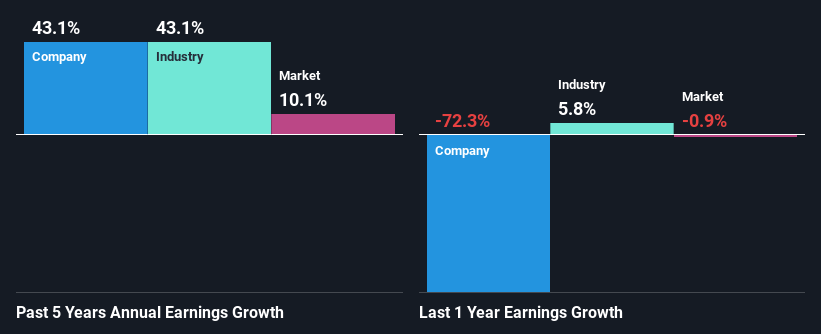Does The Market Have A Low Tolerance For First Ship Lease Trust's (SGX:D8DU) Mixed Fundamentals?
It is hard to get excited after looking at First Ship Lease Trust's (SGX:D8DU) recent performance, when its stock has declined 16% over the past three months. We, however decided to study the company's financials to determine if they have got anything to do with the price decline. Fundamentals usually dictate market outcomes so it makes sense to study the company's financials. Particularly, we will be paying attention to First Ship Lease Trust's ROE today.
Return on Equity or ROE is a test of how effectively a company is growing its value and managing investors’ money. In simpler terms, it measures the profitability of a company in relation to shareholder's equity.
View our latest analysis for First Ship Lease Trust
How To Calculate Return On Equity?
ROE can be calculated by using the formula:
Return on Equity = Net Profit (from continuing operations) ÷ Shareholders' Equity
So, based on the above formula, the ROE for First Ship Lease Trust is:
6.7% = US$3.7m ÷ US$55m (Based on the trailing twelve months to December 2023).
The 'return' is the income the business earned over the last year. That means that for every SGD1 worth of shareholders' equity, the company generated SGD0.07 in profit.
What Is The Relationship Between ROE And Earnings Growth?
We have already established that ROE serves as an efficient profit-generating gauge for a company's future earnings. Depending on how much of these profits the company reinvests or "retains", and how effectively it does so, we are then able to assess a company’s earnings growth potential. Generally speaking, other things being equal, firms with a high return on equity and profit retention, have a higher growth rate than firms that don’t share these attributes.
First Ship Lease Trust's Earnings Growth And 6.7% ROE
On the face of it, First Ship Lease Trust's ROE is not much to talk about. We then compared the company's ROE to the broader industry and were disappointed to see that the ROE is lower than the industry average of 9.9%. Despite this, surprisingly, First Ship Lease Trust saw an exceptional 43% net income growth over the past five years. So, there might be other aspects that are positively influencing the company's earnings growth. Such as - high earnings retention or an efficient management in place.
Next, on comparing First Ship Lease Trust's net income growth with the industry, we found that the company's reported growth is similar to the industry average growth rate of 43% over the last few years.
Earnings growth is a huge factor in stock valuation. What investors need to determine next is if the expected earnings growth, or the lack of it, is already built into the share price. By doing so, they will have an idea if the stock is headed into clear blue waters or if swampy waters await. One good indicator of expected earnings growth is the P/E ratio which determines the price the market is willing to pay for a stock based on its earnings prospects. So, you may want to check if First Ship Lease Trust is trading on a high P/E or a low P/E, relative to its industry.
Is First Ship Lease Trust Making Efficient Use Of Its Profits?
First Ship Lease Trust has very a high LTM (or last twelve month) payout ratio of 723% suggesting that the company's shareholders are getting paid from more than just the company's earnings. However, this hasn't hampered its ability to grow as we saw earlier. With that said, it could be worth keeping an eye on the high payout ratio as that's a huge risk. You can see the 3 risks we have identified for First Ship Lease Trust by visiting our risks dashboard for free on our platform here.
Moreover, First Ship Lease Trust is determined to keep sharing its profits with shareholders which we infer from its long history of four years of paying a dividend.
Conclusion
In total, we're a bit ambivalent about First Ship Lease Trust's performance. Although the company has shown a pretty impressive growth in earnings, yet the low ROE and the low rate of reinvestment makes us skeptical about the continuity of that growth, especially when or if the business comes to face any threats. Until now, we have only just grazed the surface of the company's past performance by looking at the company's fundamentals. So it may be worth checking this free detailed graph of First Ship Lease Trust's past earnings, as well as revenue and cash flows to get a deeper insight into the company's performance.
Have feedback on this article? Concerned about the content? Get in touch with us directly. Alternatively, email editorial-team (at) simplywallst.com.
This article by Simply Wall St is general in nature. We provide commentary based on historical data and analyst forecasts only using an unbiased methodology and our articles are not intended to be financial advice. It does not constitute a recommendation to buy or sell any stock, and does not take account of your objectives, or your financial situation. We aim to bring you long-term focused analysis driven by fundamental data. Note that our analysis may not factor in the latest price-sensitive company announcements or qualitative material. Simply Wall St has no position in any stocks mentioned.

 Yahoo Finance
Yahoo Finance 
